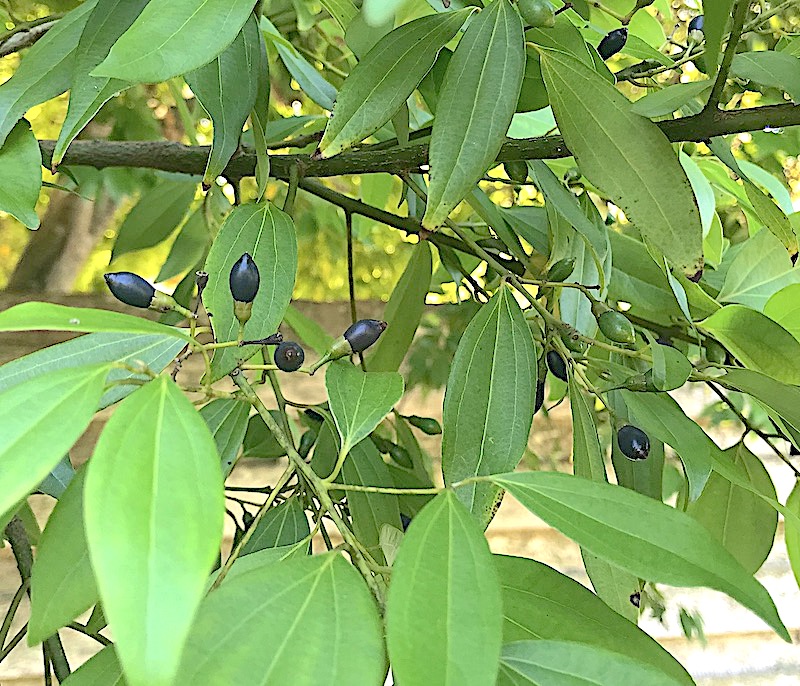
lf you were wondering, Cinnamon trees do grow in Florida. Photo by Green Deane
As is often the case one can walk past edible species many times and not notice them. What can bring them to your attention is that they change in some way, often fruiting. This was the case with a Spanish Cherry in Dreher Park in West Palm Beach. I walked past it for years until it was fruiting one day. This was also the situation with a Cinnamon Tree we saw in Sarasota last Sunday during a foraging class: It was fruiting. In fact, the back yard it was growing in also has a Loquat and some tropical yellow-blossomed tree. I was walking over to look at those when I saw this third tree crowded in. Large and fruiting, it had slightly aromatic leaves. Someone suggest Cinnamon and I had to admit I had no idea what it was though the fruit reminded of elongated Camphor fruit which is in the same genus as Cinnamon. The leaves were slightly aromatic. It’s the inner bark of the Cinnamon Tree that is used for flavoring and do know two species are used for spice purposes. You might want to make a distinction regarding which one you consume. There is the Chinese Cinnamon, and the Ceylon Cinnamon.
Chinese Cinnamon is the most common, sold in bulk, and the one used in commercial recipes such as cinnamon buns. When you buy “cinnamon” powder or “quills” (bark rolls) in the grocery story it is usually the Chinese Cinnamon, botanically Cinnamomum aromaticum which is also called Cinnamomum cassia. Its quills, which are really rolls of cambium, are dark brown-red in color and have a rough texture. Ceylon Cinnamon is from India and Sri Lanka. Botanically it is Cinnamomum verum and is also called Cinnamomum zeylanicum. Its quills are tan-brown and have a soft texture. Ceylon Cinnamon is, as one might suspect, significantly more expensive than Chinese Cinnamon. (A quick way to tell them apart before bark processings is the Chinese Cinnamon has longitudinal striations on young branches, below left. )
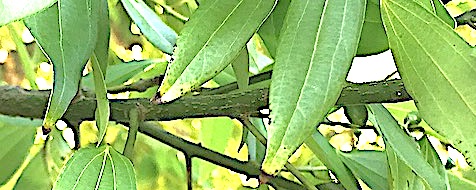
Young Chinese Cinnamon bark has longitudinal lines. Photo by Green Deane
The key essential oil in both species is cinnamaldehyde. It gives cinnamon its flavor and aroma. However the Ceylon Cinnamon has less of that oil than the Chinese cinnamon so it has a less intense flavor. It is also very low in a chemical call courmarin. Chinese Cinnamon is significantly higher in coumarin. Courmarin reduces clotting like the drug Coumadin does (and how the medication got it name. See my article on Sweet Clover.) Chinese Cinnamon is 1% coumarin and can amplify the effects of other blood thinners. Ceylon Cinnamon at 0.004% has 250 times less coumarin (if I have my zeros in the right place.) If you eat a lot of cinnamon you might want to switch to the Ceylon variety (sold at Whole Foods et cetera.) One or two teaspoons of Chinese Cinnamon can put you over the daily limit for coumarin. In some European countries commercial bakeries are prevented by law from using the Chinese Cinnamon because of the high coumarin content. On the other hand if you eat a huge amounts of leafy greens that might provide enough Vitamin K1 to off set the reduction of clotting caused by the coumarin. It could be a nutritional balancing act. Just know there are two kinds of cinnamon, they vary in price, availability, intensity of flavor, in their coumarin content, and in their ability to reduce blood clotting… and they will grow in Florida.
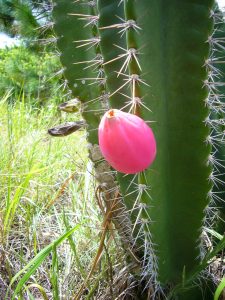
An easy to find and eat wild edible. Photo by Green Deane
One of the easiest wild fruits to identify, especially this time of year, is non-commercial “Dragon Fruit.” They look like small pink footballs on candlestick cactus (species Cereus.) What’s unusual about these pink pods is they are spineless and the seeds are soft thus you can cut them off the cactus and eat them out of hand. Or, you can chill them in the refrigerator. The white inside has the texture of an overripe watermelon and the black seeds are soft. Definitely a treat. While you can cut them off with a knife a pair of nippers works best. Which exact species you have can be elusive though the pink fruit is edible on all of them. The “genus” has many false, wrong and/or archaic names. It does not help that retailers a century ago often just made up names. Often found in landscaping and old lawn-waste piles, they are tall and ribbed with clusters of long thorns on the ribs. The blossoms are cream-green in color, large, and open at night. You can read more about the cactus here.

Foraging classes are held rain, shine, hot or cold. Photo by Nermina Krenata
Foraging Classes: It’s the time of year to begin visiting places a bit too warm in the summer such as Haul Over Canal. Also this weekend there will be a class in Gainesville. As the weather has changed perhaps we’ll see some Ringless Honey Mushrooms.
Saturday October 19th, Boulware Springs Park, 3420 SE 15th St., Gainesville, FL 32641. 9 a.m. to noon. Meet at the picnic tables next to the pump house.
Sunday, October 20th, Haulover Canal, Merritt Island National Refuge, north of the Kennedy Space Center. 9 a.m. to noon. Meet at the west end of the northwest canal road. This class meets about twice a year because federal authorities can close the area without notice. This location requires the most walking, about four miles total.
Saturday October 26th, Wickham Park: 2500 Parkway Drive, Melbourne, FL 9 a.m. to noon. Meet at the dog park.
Sunday October 27th, Colby-Alderman Park: 1099 Massachusetts Street, Cassadaga, Fl., 9 a.m. to noon. Meet near the bathrooms.
Saturday Nov. 2nd, John Chestnut County Park: 2200 East Lake Road, Palm Harbor, FL 34685. 9 a.m. to noon. Meet at the beginning of the Peggy Park Trail inside the park.
Sunday, November 3rd, Mead Garden: 1500 S. Denning Dr., Winter Park, FL 32789. 9 a.m. to noon. Meet in the parking lot near the rest rooms.
Saturday November 9th, Blanchard Park, 10501 Jay Blanchard Trail, Orlando, FL 32817. 9 a.m. to noon. Meet next to the tennis courts by the YMCA building.
Sunday, November 10th, Lake Woodruff National Wildlife Refuge, 2045 Mud Lake Road, DeLeon Springs, FL. 9 a.m. to noon. This class is rare because the federal property can be closed without notice. Meet at the first parking lot west of the railroad tracks.
Saturday, November 16th, Florida State College, south campus, 11901 Beach Blvd., Jacksonville, 32246. 9 a.m. to noon. We will meet at building “D” next to the administration parking lot.
Sunday, November 17th, Eagle Park Lake, 1800 Keene Road, Largo, FL 33771. 9 a.m. to noon. Meet at the pavilion by the dog park.
Saturday, November 23rd, Dreher Park, 1200 Southern Blvd., West Palm Beach, 33405. 9 a.m. to noon. Meet in the parking lot just north of the science center.
Sunday, November 24th, Bayshore Live Oak Park, Bayshore Drive. Port Charlotte. 9 a.m. to noon. Meet at the parking lot at the intersection of Bayshore Road and Ganyard Street. 9 a.m. to noon.
For more information about the classes, to sign up or to pre-pay for one go here.
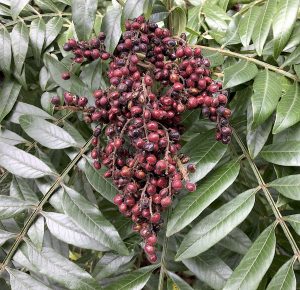
Winged Sumac, berries are tart like an apple. Photo by Green Deane
Our Sumacs are happy. Everywhere you go now they are sporting terminal clusters of garnet-colored berries. It’s time to harvest Sumacs for use today or next year. There’s a wide variety of Sumacs. Locally it’s the “Winged Sumac” Rhus copallina which means “sticky red.” In other areas of the country it can be the Staghorn Sumac. Shapes and quality vary but they always have terminal clusters of garnet-colored berries, give or take a hue. The berries have hair on them. And on the hair is malic acid, the acid that makes apples tart. You can rinse the acid off and make a vitamin-C rich “lemonade.” The berries can then be dried, ground, and used as a spice. And in the springs the shoots can be peeled and eaten raw or cooked. If you are worried about Poison Sumac it grows only in wet spots, has a much different leaf, and when in fruit has white berries positioned farther down the stem, not terminal clusters. Also Poison Sumac leaves have bright red stems.
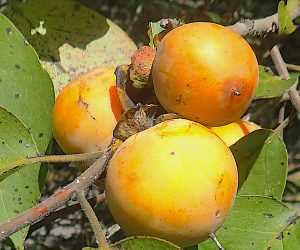
The best persimmons are the ones you have to fight the ants for. Photo by Green Deane
Besides the aforementioned Sumac what you should also be finding now are Persimmons and Saw Palmetto berries, just about the opposite on the flavor scale, sublime to you-gotta-be-kidding-me. Saw Palmetto berries ripen about mid-September but stay around for a month or more. They are strong flavored so try only a little. Their flavor reminds one of vomit. I also had a ripe persimmon a month ago but they are more an mid-October fruit. They are just coming into season locally where I look for them every year. Sometimes you can find them as lated as January locally. As for other seasonal forageables Creeping Cucumbers are still producing as are Cocoplums and Simpson Stoppers featured in last week’s newsletter.
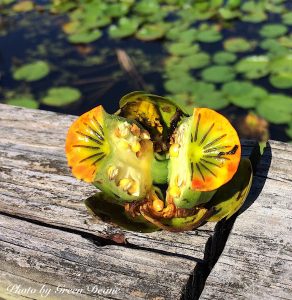
Yellow Pond Lily seeds resemble corn kernels. Photo by Green Deane
This might be a good time to write about Yellow Pond Lilys. While they fruit rather continuously the pond residents are putting forth a fall crop now. Plants may not have a brain they can have a strategy, or at least so it seems. Many of them protect their seeds in various ways until they are ready to germinate. The Persimmon Tree above comes to mind. The fruit is astringent until the seeds are mature enough to germinate. Then the fruit turns sweet attracting various animals to eat it — those that can taste sweet — to spread the seeds around. The Yellow Pond Lily works in a similar fashion. Seeds that are not ready to germinate are bitter. As the plant dies the floating seed pod rots over a three week period. When the seeds are ready to germinate the protective bitterness is removed by enzymatic action. This makes the seeds also edible. Of course we humans can take advantage of the system by collecting the seed pods ourselves and controlling the rotting process (by putting them in water for three weeks.) Then we get the seeds and dry them for use in various ways. You can read more about the Yellow Pond Lily here.
 Donations: I had a large donation last week. Thank you very much. It was timely as WordPress went down for several days. If anyone would like to donate to this website and newsletter they can use this Go Fund Me link, this PayPal donation link or by writing to Green Deane POB 941793 Maitland FL, 32794. Again, thank you.
Donations: I had a large donation last week. Thank you very much. It was timely as WordPress went down for several days. If anyone would like to donate to this website and newsletter they can use this Go Fund Me link, this PayPal donation link or by writing to Green Deane POB 941793 Maitland FL, 32794. Again, thank you.

Foraging DVDs make a good gift to watch during the lifeless months of winter.
Foraging DVDs make a good gift to watch during the lifeless months of winter. All My Videos are available for free on You Tube. They do have ads on them so every time you watch a Green Deane video I get a quarter of one cent. Four views, one cent. Not exactly a large money-maker but it helps pays for this newsletter. If you want to see the videos without ads and some in slightly better quality you can order the DVD set. It is nine DVDs with 15 videos on each for a total of 135 videos. Many people want their own copy of the videos or they have a slow service and its easier to order then to watch them on-line. The DVDs make a good gift for that forager you know especially as spring is … springing. Individual DVDs can also be ordered or you can pick and choose. You can order them by clicking on the button on the top right hand side of this page (if your window is open wide enough.) Or you can go here.
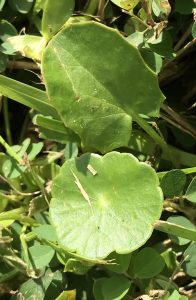 Do you recognize the edible species on the left? Both of them? If you read the Green Deane Forum you would. Perhaps you’re looking for a foraging reference? You might have a UFO, an Unidentified Flowering Object you want identified. On the Green Deane Forum we — including Green Deane and some 8,000 others from around the world — chat about foraging all year. And it’s not just about warm-weather plants or just North American flora. Many nations share common weeds so there’s a lot to talk about. There’s also more than weeds. The reference section has information for foraging around the world. There are also articles on food preservation, and forgotten skills from making bows to fermenting food.
Do you recognize the edible species on the left? Both of them? If you read the Green Deane Forum you would. Perhaps you’re looking for a foraging reference? You might have a UFO, an Unidentified Flowering Object you want identified. On the Green Deane Forum we — including Green Deane and some 8,000 others from around the world — chat about foraging all year. And it’s not just about warm-weather plants or just North American flora. Many nations share common weeds so there’s a lot to talk about. There’s also more than weeds. The reference section has information for foraging around the world. There are also articles on food preservation, and forgotten skills from making bows to fermenting food.
This is weekly newsletter 376. If you want to subscribe to this free newsletter you can find the sign-up form in the menu at the top of the page.


Hi Dean – I’ve been on one of your classes before. I’m contacting you on behalf of your friends at the Florida Trail Association (FTA) Loxahatchee Chapter. Our chapter is hosting this year’s annual FTA South Regional Conference event being held at the Tanah Keeta Scout Reservation in Tequesta, FL this December. Because we are like minded organizations, I was wondering if you might want to help me bring awareness to your cause while supporting our own? We are in need of help for: Event Sponsors, Donations / Gift Cards, Promotional Give-aways. No amount is too big or too small – All Help is Appreciated!
Let me know if there is anything you can do – maybe a complimentary access to one class we can auction off? Our group loves you…and could really benefit from your knowledge. Thanks in advance for considering it! Come join us if you like. http://www.loxfltrail.org/conference.html
Jennifer I’d love to but emailing me is quicker as I get inundated with messages. GreenDeane@gmail.com